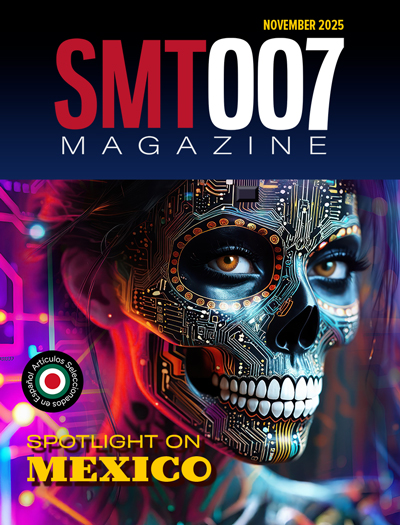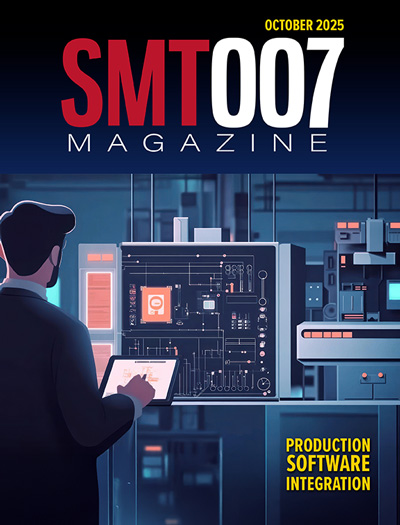-

- News
- Books
Featured Books
- smt007 Magazine
Latest Issues
Current Issue
Spotlight on Mexico
Mexico isn’t just part of the electronics manufacturing conversation—it’s leading it. From growing investments to cross-border collaborations, Mexico is fast becoming the center of electronics in North America. This issue includes bilingual content, with all feature articles available in both English and Spanish.

Production Software Integration
EMS companies need advanced software systems to thrive and compete. But these systems require significant effort to integrate and deploy. What is the reality, and how can we make it easier for everyone?

Spotlight on India
We invite you on a virtual tour of India’s thriving ecosystem, guided by the Global Electronics Association’s India office staff, who share their insights into the region’s growth and opportunities.
- Articles
- Columns
- Links
- Media kit
||| MENU - smt007 Magazine
Lean Manufacturing Principles for EMS Success
December 31, 1969 |Estimated reading time: 5 minutes
Lean manufacturing is based on cutting waste and improving quality. One EMS provider shares their path to implementing lean, with company-wide and targeted initiatives. Definitions of terms used in the Lean system are provided.
By Ross A. Clark, The Morey Corporation
EMS companies manage to survive in tough times by employing lean manufacturing principles. Lean is an overall methodology that focuses on minimizing the resources required for production by eliminating waste (non-value-added activities) that inflate costs, lead times, and inventory requirements. Lean emphasizes preventive maintenance, quality improvement programs, pull systems, and flexible work forces and production facilities. Anything that does not add value to the final product or service is eliminated. Lean manufacturing is a natural fit for EMS companies, which have high product mix environments and need to make a profit on every job no matter what the volume. The Morey Corporation's embrace of lean manufacturing maintained the company's viability and aided in the development and introduction of its own line of telematics products.
Manufacturing at the lowest cost with the highest quality is the only sustainable competitive advantage in the manufacturing world today. Toyota has shown us that lean concepts, when applied together as one cohesive strategy, will deliver that competitive advantage in the market place. Our team embarked on its lean journey with simple tools such as 5S, A3, Kaizen, flow and pull (see Definitions sidebar). These tools represent the first step toward building a culture of continuous improvement and waste elimination.
These first basic tools help engage the entire company in an improvement effort that will be sustained as a part of the EMS provider for years to come. A lean effort goes well beyond tools -- other initiates like across-the-company education programs, comprising book reviews (The Toyota Way and Lean Thinking) and case studies, add to the movement. A fundamental cultural shift must take place for lean to be successful at any company. Every employee will be touched by lean principles in one way or another, and must be empowered with knowledge and the ability to improve.
We approached lean in two ways at The Morey Corporation. A company-wide effort was made based in simple tools. A pilot factory effort was also engaged that strives to be world-class in its lean evolution. Company-wide engagement with basic tools such as 5S, Kaizen and A3's means that these tools are institutionalized. This effort imparts knowledge and encourages improvement in all areas. It also started the culture shift needed for world-class operations. Waste elimination and relentless improvement became cornerstones of the corporate culture. Executive leadership committed to these lean principles.
The effort was initiated by the formation of a lean implementation team (LIT), which helped drive A3 thinking and 5S across the company. Ongoing book reviews and Kaizen events continually embed lean mentality into the company's culture. The benefits of lean are magnified by engaging every area in a quest for improvement, with the goal of being self-sustaining and self-improving. Weekly tutorials teach employees how to build quality A3's that deliver true benefit to the company. A3 quality is directly related to the benefit delivered. Every LIT member teaches single point lessons to individual employees on a weekly basis. In the last six months, The Morey Corp. held more than 50 Kaizen events ranging in duration from an entire day to as few as two hours. These Kaizen events propel companies along their improvement journey.

Figure 1. Employees all engage in the lean mentality, which is more important than the implementation of lean tools.
The deeper dive into lean has been the pilot line. The pilot line's purpose is to prove the concept and demonstrate lean implementation to its deepest levels. Simple lean tools such as Kanban and Andon were used. Some complex tools such as Pull, Jidoka (mentality), and Takt time were also implemented. First, the line was structured along a value stream instead of in terms of manufacturing departments. After going through some basic implementation of 5S, Andons, team leaders, and a scheduling board, the concept of pull was initiated. High quality, delivery, and throughput targets were set. The Jidoka mentality (stop and fix the problem) became the core driver for quality improvement. Fixing problems fast and forever supersedes throughput or other cost metrics. We intentionally pressure quality, not throughput. There is a natural throughput pressure built into the line via Takt Time. The Jidoka pressure improves quality.
Conclusion
We are focusing more on the lean culture and mentality than the tools. It is fairly easy to install the tools. True sustainable implementation of lean ultimately comes from a culture shift, a paradigm shift in thinking. Institutionalizing a relentless improvement mentality will ultimately be the real EMS/ODM success. Many successes and even more learning opportunities emerge from lean implementation.
We share and learn from other companies that have embraced lean as their strategic direction. Our lean journey has just begun with some simple tools and a couple of lines, with plans to evolve into a world-class lean operation and a benchmark for lean culture.
Ross A. Clark, marketing manager, The Morey Corporation, may be contacted at (630) 754-2166; rclark@moreycorp.com; www.moreycorp.com.
Definitions in the Lean Manufacturing Environment
5S: 5S is an acronym for sorting, straightening, shining, standardizing, and sustaining. It is a methodology for keeping your work and work space organized, and a basic tool that both identifies and eliminates waste.
A3: A3 is a problem-solving or continuous improvement tool that defines a goal, flow charts the existing condition and the objective condition and lists the tasks necessary to complete, and bring the project to a successful conclusion.
Kaizen: Kaizen (Japanese for "improvement") is a Japanese philosophy that focuses on continuous improvement throughout all aspects of manufacturing. Kaizen events are team brainstorming sessions design to tackle A3 improvements.
Andon: Simply means "light" in Japanese; it is the name for a visual production-control device that continuously shows changing status of the production line and sounds alerts if a problem is imminent or identified.
Jidoka: Jikoda involves stopping a line automatically when a defective part is detected, to correct the defect.
Flow: Flow means production and describes how goods, services and information are processed one piece at a time.
Kanban: Kanban is an inventory control system for tracking the flow of in-process materials through the various operations of a just-in-time production process. Kanban means "card" or "ticket" in Japanese.
Pull system: A production method in which the production of an item begins only when there is actual demand from a customer.
Takt time: Takt time is defined as the time it takes to produce a product to meet existing (Pull) demand. Takt time sets the pace for industrial manufacturing lines.


